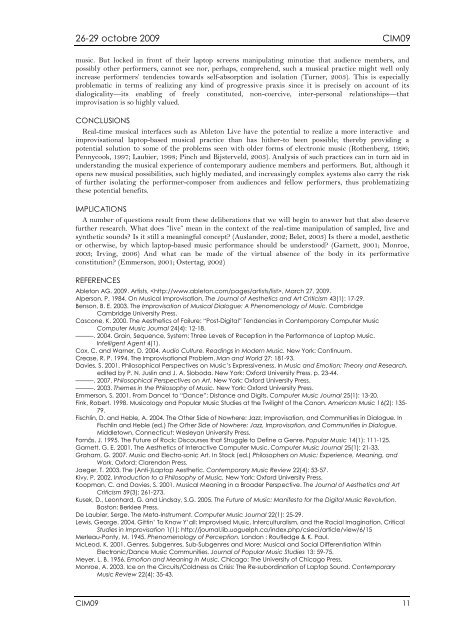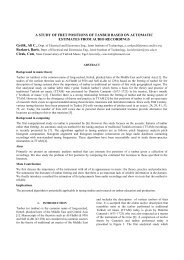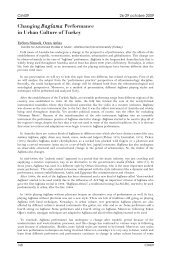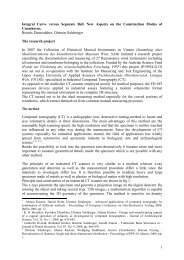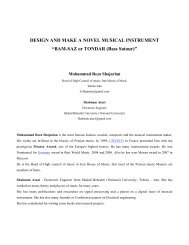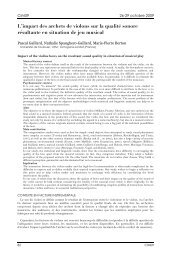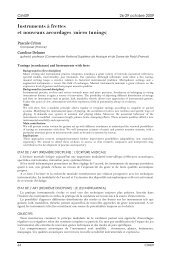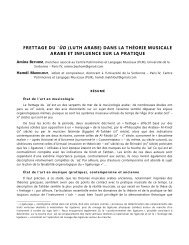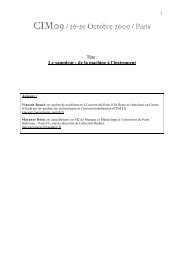<str<strong>on</strong>g>CIM09</str<strong>on</strong>g> 26-29 octobre 2009Implicati<strong>on</strong>s of Ablet<strong>on</strong> Live for improvisati<strong>on</strong>ally-basedelectr<strong>on</strong>ic music practiceMelvin BackstromMcGill University, M<strong>on</strong>tréal (Canada)Elisa NegrettoUniversity of Padua (Italy)BACKGROUND IN MUSICOLOGYOf significant c<strong>on</strong>cern to c<strong>on</strong>temporary musicology is the reciprocally c<strong>on</strong>stitutive relati<strong>on</strong>ship betweencommunities and the forms of music—both their producti<strong>on</strong> and c<strong>on</strong>sumpti<strong>on</strong>—by which they are, at leastpartly, defined (Fornäs, 1995; McLeod, 2001). However, although attenti<strong>on</strong> has been paid in this regard tothe mediatory role played by increasingly comm<strong>on</strong> laptop-based performance practice (Casc<strong>on</strong>e, 2000;Turner, 2003; Wang and Cook, 2004; Zadel and Scav<strong>on</strong>e, 2006) this has often focused <strong>on</strong> narrowlytechnical questi<strong>on</strong>s in academic and gallery c<strong>on</strong>texts without giving due c<strong>on</strong>siderati<strong>on</strong> to the widerpotentialities and c<strong>on</strong>sequences of the musical interfaces most utilized by laptop musicians today in lessexclusive, and far more comm<strong>on</strong> performance spaces; thus, replicating the high-art/low-art dichotomy fromwhich musicology, and cultural studies more broadly, has <strong>on</strong>ly recently, and still not completely, overcome(Tagg, 1987; Fink, 1998). What is therefore now needed is an interrogati<strong>on</strong> of the comm<strong>on</strong>places of laptopbasedmusic in order to better understand what results from such a radically new, but already sowidespread and influential paradigm of musical creati<strong>on</strong>.BACKGROUND IN MUSIC PHILOSOPHYIn recent years, an increasing amount of philosophical c<strong>on</strong>siderati<strong>on</strong> has been given to improvisati<strong>on</strong>almusical practice as its processes seem to offer potential insights into the ways in which inter-subjectiveexpressi<strong>on</strong> is both c<strong>on</strong>strained by, and enabled through c<strong>on</strong>textual determinati<strong>on</strong>s (Alpers<strong>on</strong>, 1984; Crease,1994; Nard<strong>on</strong>e, 1996; Nicholls, 2005). Music, particularly in live c<strong>on</strong>texts, has str<strong>on</strong>g communicative andexpressive power, and finds complex social and perceptual realizati<strong>on</strong>s (Kivy, 2002; Meyer, 1956).Following a phenomenological perspective that emphasizes and interprets the relati<strong>on</strong>s of the living beingwith the envir<strong>on</strong>ment in which he/she is immersed, studying the social aspect of musical improvisati<strong>on</strong>alpractice becomes a way to better understand the c<strong>on</strong>stituti<strong>on</strong> of the self within its social and culturalc<strong>on</strong>texts (Merleau-P<strong>on</strong>ty, 1945). The advent and use of new instrumentati<strong>on</strong> and technology offers newinsights to this philosophical investigati<strong>on</strong>, as well as to the comprehensi<strong>on</strong> of the musical, and morebroadly social experience of both performers and audience members (Bens<strong>on</strong>, 2003).AIMSThat the advent and development of digital audio over the last few decades has revoluti<strong>on</strong>ized the waymusic is produced, c<strong>on</strong>sumed, exchanged and performed borders <strong>on</strong>, if not entirely crosses into, the realm ofplatitude (Kusek, Le<strong>on</strong>hard and Lindsay, 2005; Bockstedt, Kauffman and Riggins 2005). But there has beenrelatively little theorizing of some of the musical performance possibilities opened up by the proliferati<strong>on</strong> ofportable, high-speed computers. In this paper we will attempt to redress this imbalance through adiscussi<strong>on</strong> and brief explorati<strong>on</strong> of Ablet<strong>on</strong> Live; a program notable not <strong>on</strong>ly <strong>on</strong> account of its popularity(Irving, 2006), but for its meta-instrumental capabilities. By acting as an interface between synthetic andn<strong>on</strong>-synthetic, pre-recorded and live sound sources Live allows the realizati<strong>on</strong> of a s<strong>on</strong>ic amalgamati<strong>on</strong> thatchallenges, if not entirely disrupts, the hither-to-ostensible dichotomy of live versus recorded music(Auslander, 2002; Ashline, 2003; Jaeger, 2003). Yet, Sterne’s applicati<strong>on</strong> of Bourdieu’s social theory offersimportant insights into the “c<strong>on</strong>structedness” of such technological objects, as well as of the musicalpractices that it engenders, and thus warns against a naive acceptance of their seeming objectivity (Sterne,2003).MAIN CONTRIBUTIONThe performance possibilities that Live engenders are vast as many DJs, instrumentalists and electroacousticcomposers have discovered (Ablet<strong>on</strong>, 2009). But the effect that such a meta-instrumental, andimprovisati<strong>on</strong>ally-adaptable interface might have <strong>on</strong> the musical experience of performers and audiencemembers deserves greater c<strong>on</strong>siderati<strong>on</strong>. Given the value, argued by many (Alterhaug 2004; Fischlin andHeble 2004; Lewis 2004), of improvised music in challenging the hierarchical relati<strong>on</strong>ships that havehistorically suffused musical practices Live may exemplify the progressive potentiality of c<strong>on</strong>temporary10 <str<strong>on</strong>g>CIM09</str<strong>on</strong>g>
26-29 octobre 2009 <str<strong>on</strong>g>CIM09</str<strong>on</strong>g>music. But locked in fr<strong>on</strong>t of their laptop screens manipulating minutiae that audience members, andpossibly other performers, cannot see nor, perhaps, comprehend, such a musical practice might well <strong>on</strong>lyincrease performers’ tendencies towards self-absorpti<strong>on</strong> and isolati<strong>on</strong> (Turner, 2003). This is especiallyproblematic in terms of realizing any kind of progressive praxis since it is precisely <strong>on</strong> account of itsdialogicality—its enabling of freely c<strong>on</strong>stituted, n<strong>on</strong>-coercive, inter-pers<strong>on</strong>al relati<strong>on</strong>ships—thatimprovisati<strong>on</strong> is so highly valued.CONCLUSIONSReal-time musical interfaces such as Ablet<strong>on</strong> Live have the potential to realize a more interactive andimprovisati<strong>on</strong>al laptop-based musical practice than has hither-to been possible; thereby providing apotential soluti<strong>on</strong> to some of the problems seen with older forms of electr<strong>on</strong>ic music (Rothenberg, 1996;Pennycook, 1997; Laubier, 1998; Pinch and Bijsterveld, 2003). Analysis of such practices can in turn aid inunderstanding the musical experience of c<strong>on</strong>temporary audience members and performers. But, although itopens new musical possibilities, such highly mediated, and increasingly complex systems also carry the riskof further isolating the performer-composer from audiences and fellow performers, thus problematizingthese potential benefits.IMPLICATIONSA number of questi<strong>on</strong>s result from these deliberati<strong>on</strong>s that we will begin to answer but that also deservefurther research. What does “live” mean in the c<strong>on</strong>text of the real-time manipulati<strong>on</strong> of sampled, live andsynthetic sounds? Is it still a meaningful c<strong>on</strong>cept? (Auslander, 2002; Belet, 2003) Is there a model, aestheticor otherwise, by which laptop-based music performance should be understood? (Garnett, 2001; M<strong>on</strong>roe,2003; Irving, 2006) And what can be made of the virtual absence of the body in its performativec<strong>on</strong>stituti<strong>on</strong>? (Emmers<strong>on</strong>, 2001; Ostertag, 2002)REFERENCESAblet<strong>on</strong> AG. 2009. Artists, , March 27, 2009.Alpers<strong>on</strong>, P. 1984. On Musical Improvisati<strong>on</strong>. The Journal of Aesthetics and Art Criticism 43(1): 17-29.Bens<strong>on</strong>, B. E. 2003. The Improvisati<strong>on</strong> of Musical Dialogue: A Phenomenology of Music. CambridgeCambridge University Press.Casc<strong>on</strong>e, K. 2000. The Aesthetics of Failure: “Post-Digital” Tendencies in C<strong>on</strong>temporary Computer MusicComputer Music Journal 24(4): 12-18.———. 2004. Grain, Sequence, System: Three Levels of Recepti<strong>on</strong> in the Performance of Laptop Music.Intelligent Agent 4(1).Cox, C. and Warner, D. 2004. Audio Culture. Readings in Modern Music. New York: C<strong>on</strong>tinuum.Crease, R. P. 1994. The Improvisati<strong>on</strong>al Problem. Man and World 27: 181-93.Davies, S. 2001. Philosophical Perspectives <strong>on</strong> Music’s Expressiveness. In Music and Emoti<strong>on</strong>: Theory and Research,edited by P. N. Juslin and J. A. Sloboda. New York: Oxford University Press. p. 23-44.———. 2007. Philosophical Perspectives <strong>on</strong> Art. New York: Oxford University Press.———. 2003. Themes in the Philosophy of Music. New York: Oxford University Press.Emmers<strong>on</strong>, S. 2001. From Dance! to “Dance”: Distance and Digits. Computer Music Journal 25(1): 13-20.Fink, Robert. 1998. <strong>Musicology</strong> and Popular Music Studies at the Twilight of the Can<strong>on</strong>. American Music 16(2): 135-79.Fischlin, D. and Heble, A. 2004. The Other Side of Nowhere: Jazz, Improvisati<strong>on</strong>, and Communities in Dialogue. InFischlin and Heble (ed.) The Other Side of Nowhere: Jazz, Improvisati<strong>on</strong>, and Communities in Dialogue.Middletown, C<strong>on</strong>necticut: Wesleyan University Press.Fornäs, J. 1995. The Future of Rock: Discourses that Struggle to Define a Genre. Popular Music 14(1): 111-125.Garnett, G. E. 2001. The Aesthetics of Interactive Computer Music. Computer Music Journal 25(1): 21-33.Graham, G. 2007. Music and Electro-s<strong>on</strong>ic Art. In Stock (ed.) Philosophers <strong>on</strong> Music: Experience, Meaning, andWork. Oxford: Clarend<strong>on</strong> Press.Jaeger, T. 2003. The (Anti-)Laptop Aesthetic. C<strong>on</strong>temporary Music Review 22(4): 53-57.Kivy, P. 2002. Introducti<strong>on</strong> to a Philosophy of Music. New York: Oxford University Press.Koopman, C. and Davies, S. 2001. Musical Meaning in a Broader Perspective. The Journal of Aesthetics and ArtCriticism 59(3): 261-273.Kusek, D., Le<strong>on</strong>hard, G. and Lindsay, S.G. 2005. The Future of Music: Manifesto for the Digital Music Revoluti<strong>on</strong>.Bost<strong>on</strong>: Berklee Press.De Laubier, Serge. The Meta-Instrument. Computer Music Journal 22(1): 25-29.Lewis, George. 2004. Gittin’ To Know Y’all: Improvised Music, Interculturalism, and the Racial Imaginati<strong>on</strong>. CriticalStudies in Improvisati<strong>on</strong> 1(1): http://journal.lib.uoguelph.ca/index.php/csieci/article/view/6/15Merleau-P<strong>on</strong>ty, M. 1945. Phenomenology of Percepti<strong>on</strong>. L<strong>on</strong>d<strong>on</strong> : Routledge & K. Paul.McLeod, K. 2001. Genres, Subgenres, Sub-Subgenres and More: Musical and Social Differentiati<strong>on</strong> WithinElectr<strong>on</strong>ic/Dance Music Communities. Journal of Popular Music Studies 13: 59-75.Meyer, L. B. 1956. Emoti<strong>on</strong> and Meaning in Music. Chicago: The University of Chicago Press.M<strong>on</strong>roe, A. 2003. Ice <strong>on</strong> the Circuits/Coldness as Crisis: The Re-subordinati<strong>on</strong> of Laptop Sound. C<strong>on</strong>temporaryMusic Review 22(4): 35-43.<str<strong>on</strong>g>CIM09</str<strong>on</strong>g> 11
- Page 1 and 2: CIM095 e Congrès
- Page 4 and 5: INTRODUCTIONLe Congrès Interdiscip
- Page 8 and 9: SOMMAIREMécanique de l'archet de v
- Page 12 and 13: CIM09 26-29 octobr
- Page 14: CIM09 26-29 octobr
- Page 18 and 19: CIM09 26-29 octobr
- Page 22 and 23: CIM09 26-29 octobr
- Page 24 and 25: CIM09 26-29 octobr
- Page 26 and 27: CIM09 26-29 octobr
- Page 28 and 29: CIM09 26-29 octobr
- Page 30 and 31: CIM09 26-29 octobr
- Page 32 and 33: CIM09 26-29 octobr
- Page 34 and 35: CIM09 26-29 octobr
- Page 36 and 37: CIM09 26-29 octobr
- Page 38 and 39: CIM09 26-29 octobr
- Page 40 and 41: CIM09 26-29 octobr
- Page 42 and 43: CIM09 26-29 octobr
- Page 44 and 45: CIM09 26-29 octobr
- Page 46 and 47: CIM09 26-29 octobr
- Page 48 and 49: CIM09 26-29 octobr
- Page 50 and 51: CIM09 26-29 octobr
- Page 52 and 53: CIM09 26-29 octobr
- Page 54 and 55: CIM09 26-29 octobr
- Page 56 and 57: CIM09 26-29 octobr
- Page 58 and 59: CIM09 26-29 octobr
- Page 60 and 61: CIM09 26-29 octobr
- Page 62 and 63: CIM09 26-29 octobr
- Page 64 and 65: CIM09 26-29 octobr
- Page 66 and 67: CIM09 26-29 octobr
- Page 68 and 69: CIM09 26-29 octobr
- Page 70 and 71:
CIM09 26-29 octobr
- Page 72 and 73:
CIM09 26-29 octobr
- Page 74 and 75:
CIM09 26-29 octobr
- Page 76 and 77:
CIM09 26-29 octobr
- Page 78 and 79:
CIM09 26-29 octobr
- Page 80 and 81:
CIM09 26-29 octobr
- Page 82 and 83:
CIM09 26-29 octobr
- Page 84 and 85:
CIM09 26-29 octobr
- Page 86 and 87:
CIM09 26-29 octobr
- Page 88 and 89:
CIM09 26-29 octobr
- Page 90 and 91:
CIM09 26-29 octobr
- Page 92 and 93:
CIM09 26-29 octobr
- Page 94 and 95:
CIM09 26-29 octobr
- Page 96 and 97:
CIM09 26-29 octobr
- Page 98 and 99:
CIM09 26-29 octobr
- Page 100 and 101:
CIM09 26-29 octobr
- Page 102 and 103:
CIM09 26-29 octobr
- Page 104 and 105:
CIM09 26-29 octobr
- Page 106 and 107:
CIM09 26-29 octobr
- Page 108 and 109:
CIM09 26-29 octobr
- Page 110 and 111:
CIM09 26-29 octobr
- Page 112 and 113:
CIM09 26-29 octobr
- Page 114 and 115:
CIM09 26-29 octobr
- Page 116 and 117:
CIM09 26-29 octobr
- Page 118 and 119:
CIM09 26-29 octobr
- Page 120 and 121:
CIM09 26-29 octobr
- Page 122 and 123:
CIM09 26-29 octobr
- Page 124 and 125:
CIM09 26-29 octobr
- Page 126 and 127:
CIM09 26-29 octobr
- Page 128 and 129:
CIM09 26-29 octobr
- Page 130 and 131:
CIM09 26-29 octobr
- Page 132 and 133:
CIM09 26-29 octobr
- Page 134 and 135:
CIM09 26-29 octobr
- Page 136 and 137:
CIM09 26-29 octobr
- Page 138 and 139:
CIM09 26-29 octobr
- Page 140 and 141:
CIM09 26-29 octobr
- Page 142 and 143:
CIM09 26-29 octobr
- Page 144 and 145:
CIM09 26-29 octobr
- Page 146 and 147:
CIM09 26-29 octobr
- Page 148 and 149:
CIM09 26-29 octobr
- Page 150 and 151:
CIM09 26-29 octobr
- Page 152 and 153:
CIM09 26-29 octobr
- Page 154 and 155:
CIM09 26-29 octobr
- Page 156 and 157:
CIM09 26-29 octobr
- Page 158 and 159:
CIM09 26-29 octobr
- Page 160 and 161:
CIM09 26-29 octobr
- Page 162 and 163:
CIM09 26-29 octobr
- Page 164 and 165:
CIM09 26-29 octobr
- Page 166 and 167:
CIM09 26-29 octobr
- Page 168 and 169:
CIM09 26-29 octobr
- Page 170 and 171:
CIM09 26-29 octobr
- Page 172 and 173:
CIM09 26-29 octobr
- Page 174 and 175:
CIM09 26-29 octobr
- Page 176 and 177:
CIM09 26-29 octobr
- Page 178 and 179:
CIM09 26-29 octobr
- Page 180 and 181:
CIM09 26-29 octobr
- Page 182 and 183:
CIM09 26-29 octobr
- Page 184 and 185:
CIM09 26-29 octobr
- Page 186 and 187:
CIM09 26-29 octobr
- Page 188:
CIM09 26-29 octobr
- Page 191 and 192:
Kotta K.,110Lagrée,38Lähdeoja,112


